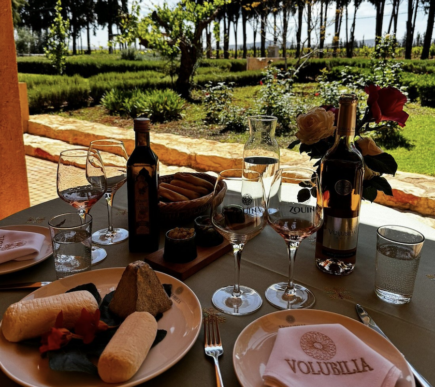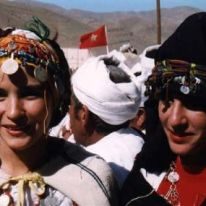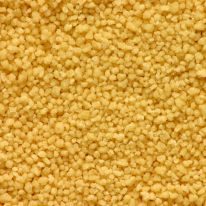
There’s something magical about standing in a centuries-old kitchen in Fes, Morocco’s culinary capital, watching steam rise from a simmering tagine as the call to prayer echoes through the medina. After spending five incredible days exploring the gastronomic treasures of this ancient city on a Fes 5-Day Culinary Tour, I can tell you that this UNESCO isn’t just a destination – it’s a feast for all the senses.
The Soul of Moroccan Cooking
The moment you step through Bab Boujeloud, the iconic Blue Gate of Fes, you’re transported into a world where culinary traditions have remained unchanged for generations. Here, in the world’s largest car-free urban area, every winding alley tells a story of Morocco’s rich gastronomic heritage, where Arab, Moorish, Jewish, French, and Amazigh influences blend seamlessly in every dish.

A Journey Through Time in the Medina on a Fes 5-Day Culinary Tour
My adventure began in the heart of the UNESCO-listed medina, where morning light filtered through the latticed woodwork of ancient buildings. As part of the comprehensive Fes food tour, we delved deep into the culinary traditions that have shaped this imperial city for over 1,200 years. Our first stop was a 400-year-old communal bakery, where the furnatchi still uses traditional methods to bake bread for the entire neighborhood. The aroma of fresh khobz (Moroccan bread) mingling with the scent of wild honey and exotic spices created an unforgettable sensory experience.
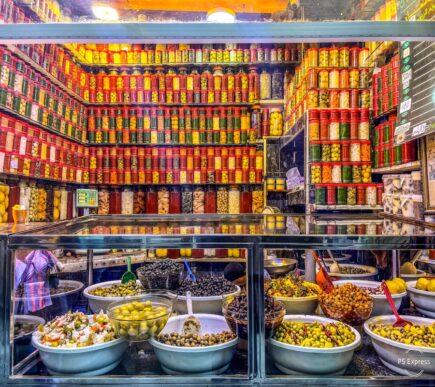
The labyrinthine alleys of Fes’s medina led us to hidden culinary treasures that few tourists discover. In dimly lit storerooms, we found towering clay jars filled with preserved lemons and a rainbow of cured olives – time-honored ingredients that form the backbone of Fassi cuisine. The lemons, packed in salt and their own juice for months, develop a unique mellowed tartness that’s essential to traditional tagines.
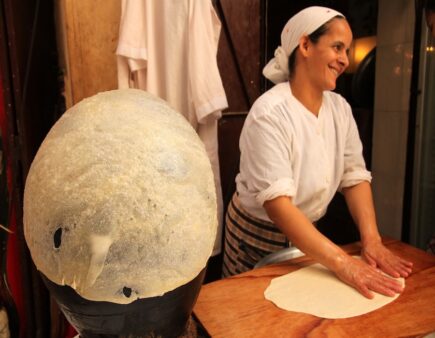
Our expert guide, a native of the ancient city, shared stories passed down through generations while introducing us to local artisans preserving centuries-old food traditions. In one memorable moment, we watched as an elderly woman demonstrated the mesmerizing art of hand-rolling couscous, a technique she learned from her grandmother over 60 years ago. We also witnessed Fassi women making warqa (ورقة), a Moroccan specialty of paper-thin pastry dough even more delicate than phyllo, essential for creating the city’s renowned bastilla.
Throughout the Fes 5-Day culinary tour, we explored the seasonal rhythms of Moroccan cuisine, from early morning visits to the spice markets to evening feasts in traditional riads. We learned how the city’s position at the crossroads of ancient trade routes influenced its distinctive cooking style, combining Andalusian, Berber, and Arabic influences into something uniquely Fassi.
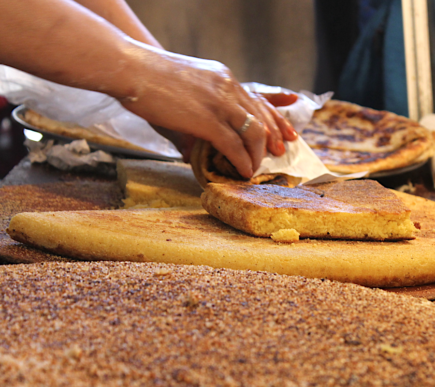
What You Will Eat on a Fes Food Tour
On a food tour through Fes, you’ll discover a rich tapestry of traditional Moroccan delicacies. Begin your culinary journey with msemen, flaky square-shaped Moroccan pancakes featuring delicate folded dough layers, perfectly complemented by honey and aged butter. For breakfast, savor harsha, a golden cornmeal bread known for its contrasting crispy exterior and soft interior, traditionally paired with refreshing mint tea. The tour includes briouats, crispy phyllo pastries filled with your choice of meat, fish, or cheese, each enhanced by local spice blends.
Street food enthusiasts will delight in makouta, traditional Moroccan potato cakes seasoned with cumin and herbs. The experience continues with a tasting of eight distinct artisanal wild honeys, each offering unique flavor profiles from different regions. You’ll also sample local specialties of Fes, including aged butter and khlia, a spicy dried beef preparation. The medina’s spice souks contribute their aromatic blends to various potato specialties, including spicy potato cakes.
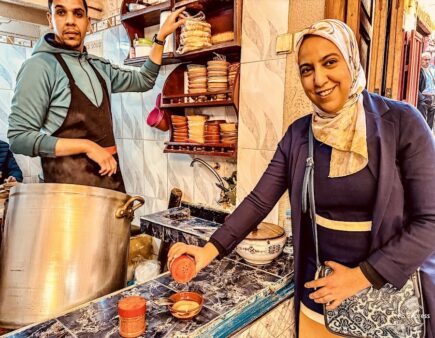
The Fes food experience features a selection of traditional soups, from the hearty bisara made with fava beans to the comforting harira prepared with tomatoes and lentils, along with seasonal varieties. Refresh yourself with fresh fruit juices pressed from pomegranates, oranges, and seasonal fruits harvested from local orchards. The experience is further enriched by premium dates, including luxurious Medjool and Deglet Noor varieties, often served with almond stuffing. Finally, discover local olives cured using time-honored preservation methods, incorporating traditional herbs and spices that reflect centuries of culinary expertise.
Hidden Culinary Treasures
Each day brought new discoveries. In the honey souk, I sampled eight distinct varieties of wild honey, each telling its own story of Morocco’s diverse landscapes. The spice merchants shared their secrets for creating the perfect ras el hanout blend, while in the olive markets, vendors offered tastings of their family’s centuries-old preservation methods.
From Market to Table
The cooking classes were a highlight of the journey. In a traditional riad kitchen, we learned to balance the subtle flavors of preserved lemon with saffron, and mastered the art of creating the paper-thin warka dough used in pastilla. Our female instructor, a master of Fassi cuisine, shared family recipes that had been passed down through generations on our Fes -5-Day Culinary Tour.
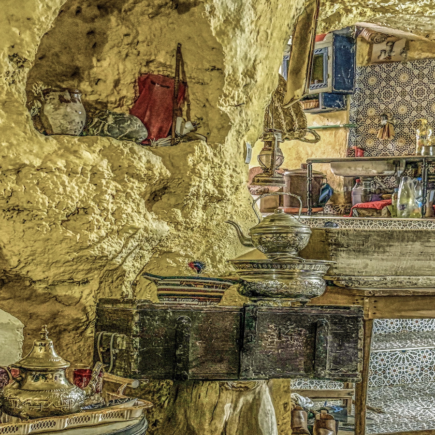
Beyond the Medina Walls
The journey extended beyond Fes to the enchanting village of Bhalil, a hidden gem nestled in the Middle Atlas Mountains. This unique settlement is famous for its cave dwellings, known locally as “ghar,” which have been continuously inhabited for centuries. In one of these remarkable cave homes, carved into the mountainside, we participated in an immersive cooking class led by a local family who has lived there for generations. The cave’s natural temperature control created the perfect environment for learning traditional Moroccan cooking techniques. Our host demonstrated how to prepare authentic dishes like tender lamb tagine with preserved lemons and homemade bread baked in centuries-old stone ovens. The intimate setting allowed us to experience not just the cuisine, but also the daily rhythms of cave dwelling life that has remained largely unchanged for hundreds of years.
A Visit to Ancient Volubilis
The experience culminated with a visit to the Roman ruins of Volubilis, where exquisitely preserved mosaics tell tales of the region’s rich history. Standing among these ancient stones, you can’t help but reflect on how the culinary traditions of Morocco have endured through centuries of change.
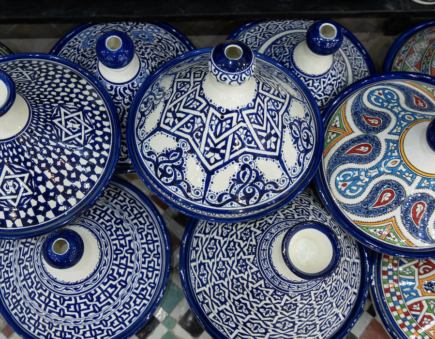
Artisanal Treasures
No culinary journey to Fes would be complete without exploring the artisanal crafts that make Moroccan dining so special. The medina’s workshops produce everything from traditional blue-glazed tagines to hand-tooled leather knife rolls and intricately embroidered table linens – each piece a testament to the city’s dedication to culinary craftsmanship.
A Traveler’s Tale: Gina’s Moroccan Food Journey
“I never imagined that five days could change the way I think about food forever,” says Ginna Bernstein, a home chef from the West Coast who joined the tour in fall. “From the moment I met our guide Siham at the Blue Gate, I knew this wouldn’t be an ordinary cooking vacation.”
Ginna Bernstein describes her highlight as the intimate pastry-making session with a local family. “There we were, in their traditional kitchen, learning how to fold delicate warqa pastry for pastilla while three generations of women shared their family stories. The grandmother didn’t speak English, but food became our common language.”
The cave cooking experience in Bhalil particularly struck her. “You’re literally cooking in these ancient cave dwellings that families have lived in for centuries. We made a traditional tagine, and while it simmered, our host taught us how to properly brew Moroccan mint tea. It’s these moments that you can’t plan for – they just happen naturally.”
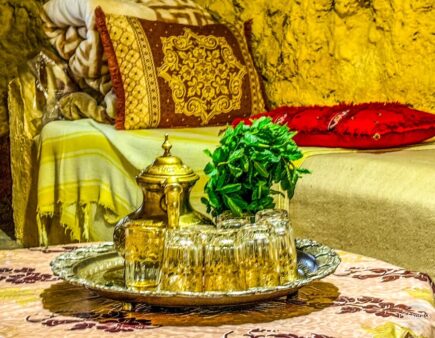
Our journey from Fes led us to the enchanting village of Bhalil, a hidden gem nestled in the Middle Atlas Mountains. This unique settlement is famous for its cave dwellings, known locally as “ghar,” which have been continuously inhabited for centuries. In one of these remarkable cave homes, carved into the mountainside, we participated in an immersive cooking class led by a local family who has lived there for generations. The cave’s natural temperature control created the perfect environment for learning traditional Moroccan cooking techniques.
Our host demonstrated how to prepare authentic dishes like tender lamb tagine with preserved lemons and homemade bread baked in centuries-old stone ovens. The intimate setting allowed us to experience not just the cuisine, but also the daily rhythms of cave dwelling life that has remained largely unchanged for hundreds of years. After the cooking class, we explored the village’s winding pathways, observing local artisans at work and learning about the fascinating architecture of these cave homes before returning to Fes.
But it wasn’t just the cooking that left an impression. “The wine tasting at Villa Volubilia, a boutique vineyard, opened my eyes to Morocco’s wine culture. Sipping locally-produced Syrah while overlooking both vineyards and ancient Roman ruins – it was surreal. And the food pairings were incredible.”
We embarked from Fes to the prestigious Villa Volubilis winery, formerly known as Domaine de la Zouina, in the fertile Meknès region. Set against the backdrop of the ancient Roman ruins of Volubilis, this 115-hectare estate represents Morocco’s renaissance in winemaking. Among perfectly aligned rows of Syrah and Cabernet Sauvignon vines, we discovered Morocco’s emerging wine culture, learning how French wine-making traditions have been adapted to this unique terroir.
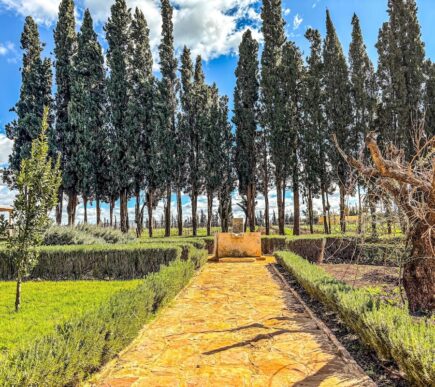
Bordered with cypresses and olive trees, the vineyard has its roots in an age-old terroir that gives its fruits a unique signature. The most noble grape varieties were selected: Syrah, Cabernet Sauvignon, Tempranillo for reds; chardonnay, sauvignon blanc, sauvignon gris, viognier, and vermentino for whites; caladoc, mourvèdre and marselan for grays and rosés. All sublimate the power and refinement of a solar and warm earth. The entire estate of Villa Volubilis is conducted in sustainable agriculture with a constant concern for quality. This is evidenced by the density of plantations (4,000 hectares per hectare to avoid any water stress), the careful tending, the grape harvest in green and the sorts that leave grapes on the spot that do not deserve to be vinified.
Ginna returned home with more than just recipes. “I brought back traditional spice blends, a handmade tagine, and the most beautiful embroidered table linens. But the real souvenirs are the techniques I learned and the connections I made. Now when I cook these dishes at home, each one brings back memories of the families who shared their culinary secrets with us.”
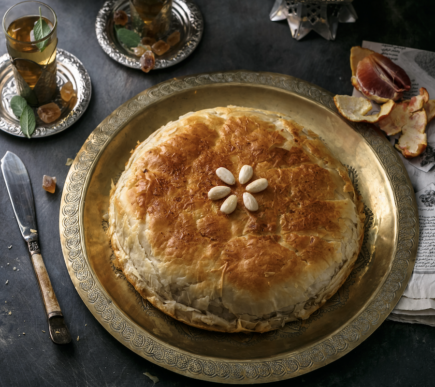
Gina’s 5-Day Culinary Tour Highlight: Making Bastilla in Fes
During Gina’s culinary adventure in Fes, she learned to make the city’s most celebrated dish – Pastilla (also spelled Bastilla or B’stilla). This regal sweet-savory pie tells the story of Fes itself, with its delicate warqa pastry wrapping around tender spiced chicken (traditionally pigeon), crushed almonds, and silky eggs. While intimidating at first, Sarah mastered the technique under the guidance of a local female chef in a traditional Moroccan kitchen.
In a traditional Moroccan kitchen, Gina discovered how to layer the delicate warqa pastry, watching as her instructor demonstrated the precise technique of brushing each paper-thin sheet with butter. The filling combined spiced chicken with saffron-infused onions, creating the complex layers of flavor that make bastilla a masterpiece of Moroccan cuisine.
Perhaps the most intricate part was learning to create the characteristic geometric pattern of powdered sugar and cinnamon on top – a technique requiring a steady hand and patient instruction from her female Fassi cooking teacher.
MOROCCAN CHICKEN PASTILLA
Preparation time: 2 hours Cooking time: 1.5 hours Serves: 8-10
INGREDIENTS: For the Filling:
- 4 chicken breasts or 1 whole chicken, cut into pieces
- 2 large onions, finely chopped
- 3 cloves garlic, minced
- 3 eggs, beaten
- 1 cup almonds, blanched and coarsely ground
- 1/2 cup fresh parsley, chopped
- 1/2 cup fresh cilantro, chopped
- 2 tablespoons olive oil
Spice Mixture:
- 2 teaspoons ground ginger
- 2 teaspoons ground cinnamon
- 1 teaspoon ground turmeric
- 1 teaspoon ground cumin
- 1/2 teaspoon ground white pepper
- 1/2 teaspoon saffron threads
- Salt to taste
For Assembly:
- 12-14 sheets phyllo dough (traditionally warqa)
- 1 cup melted butter
- 2 tablespoons powdered sugar
- 2 teaspoons ground cinnamon (for dusting)
- 1/2 cup toasted almonds (for garnish)
INSTRUCTIONS:
- Prepare the Filling:
- Heat olive oil in a large pot over medium heat
- Add onions and cook until translucent (about 5 minutes)
- Add chicken pieces, garlic, and spice mixture
- Add 1 cup water, cover, and simmer for 1 hour until chicken is tender
- Remove chicken, let cool, then shred meat off bones
- Continue cooking sauce until reduced and thickened
- Add beaten eggs to the sauce, stirring until set but still moist
- Mix in shredded chicken and chopped herbs
- Prepare Almonds:
- Toast ground almonds until golden
- Mix with 2 tablespoons powdered sugar and 1 teaspoon cinnamon
- Assemble the Pastilla:
- Preheat oven to 350°F (175°C)
- Brush a round baking pan (15-inch) with melted butter
- Layer 6 sheets of phyllo, brushing each with butter, allowing edges to hang over
- Spread chicken mixture evenly
- Sprinkle almond mixture over chicken
- Fold overhanging phyllo over filling
- Layer remaining phyllo on top, tucking edges under
- Brush top with remaining butter
- Bake:
- Bake for 30-40 minutes until golden brown
- Let cool for 10 minutes
- Garnish:
- Dust top with alternating lines of powdered sugar and cinnamon in a geometric pattern
- Sprinkle with toasted almonds
Traditional Tips:
- In Fes, this would be made with warqa, a tissue-thin Moroccan pastry. Phyllo is the closest substitute
- The balance of sweet and savory is crucial – adjust sugar and spices to taste
- Some families add scrambled eggs to the filling for extra richness
- The geometric pattern on top often features traditional Moroccan designs
This dish is typically served as a starter for special occasions and celebrations in Morocco. For more recipes on Moroccan tagine and couscous
The Perfect Moroccan Food Adventure
This immersive Fes 5-Day Culinary Tour experience is ideal for anyone who believes that understanding a culture begins in its kitchens. With luxury riad accommodations, expert guides, and intimate cooking classes, it offers an unparalleled opportunity to explore one of the world’s most fascinating culinary traditions.
Whether you’re a serious food enthusiast, a cultural explorer, or simply someone who loves to experience a place through its flavors, this journey through Fes offers something truly special. It’s more than just a cooking vacation – it’s an opportunity to become part of Morocco’s living culinary heritage.

